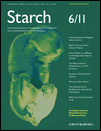The effect of tapioca maltodextrins on the stability of oil-in-water emulsions
Abstract
The effect of concentration of tapioca maltodextrin with three different DE values on the viscosity, depletion attraction potential (Wdep), rate of coalescence (Kc), and creaming rate of oil-in-water emulsion have been investigated. The relative viscosity and Wdep increased with increasing maltodextrin concentration. Critical flocculation concentration (CFC) of emulsions containing maltodextrin with DE of 16 (DE16), 12 (DE12), and 9 (DE9) were 11, 7, and 5.5 wt%, respectively. At maltodextrin concentrations below CFC, there was no change in Kc and no creaming was observed. At maltodextrin concentrations above CFC, an increase in the concentration of DE9 and DE12 resulted in an increase in Kc until it reached a constant value. Kc values remained to be constant in the concentration range between 30 and 40 wt% for DE9 and that between 35 and 45 wt% for DE12. Further increasing in concentration of DE9 and 12 decreased Kc. Kc of DE16 monotonically increased with increasing concentration from CFC to 50 wt%. The rate of creaming decreased with increasing maltodextrin concentration over CFC until it reached zero. Creaming was not observed at maltodextrin concentrations more than 35 wt% for DE9 and 40 wt% for DE12 whereas DE16 showed creaming at all concentrations above CFC. A maltodextrin with a lower DE inhibited creaming more efficiently than maltodextrin with a higher DE because of higher viscosities. The Kc tended to increase with decreasing DE because the strength of interaction between oil droplets increased.




